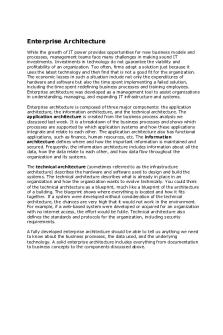Enterprise Architecture PDF

| Title | Enterprise Architecture |
|---|---|
| Course | Information Systems in Organizations |
| Institution | University of Maryland Global Campus |
| Pages | 1 |
| File Size | 34.2 KB |
| File Type | |
| Total Downloads | 55 |
| Total Views | 155 |
Summary
week 4 lecture intro...
Description
Enterprise Architecture While the growth of IT power provides opportunities for new business models and processes, management teams face many challenges in making sound IT investments. Investments in technology do not guarantee the viability and profitability of an organization. Too often, firms adopt a solution just because it uses the latest technology and then find that is not a good fit for the organization. The economic losses in such a situation include not only the expenditures of hardware and software but also the time spent implementing a failed solution, including the time spent redefining business processes and training employees. Enterprise architecture was developed as a management tool to assist organizations in understanding, managing, and expanding IT infrastructure and systems. Enterprise architecture is composed of three major components: the application architecture, the information architecture, and the technical architecture. The application architecture is created from the business process analysis we discussed last week. It is a breakdown of the business processes and shows which processes are supported by which application systems and how these applications integrate and relate to each other. The application architecture also has functional applications, such as finance, human resources, etc. The information architecture defines where and how the important information is maintained and secured. Frequently, the information architecture includes information about all the data, how the data relate to each other, and how data flow throughout the organization and its systems. The technical architecture (sometimes referred to as the infrastructure architecture) describes the hardware and software used to design and build the systems. The technical architecture describes what is already in place in an organization and how the organization wants to evolve technically. You could think of the technical architecture as a blueprint, much like a blueprint of the architecture of a building. The blueprint shows where everything is located and how it fits together. If a system were developed without consideration of the technical architecture, the chances are very high that it would not work in the environment. For example, if a web-based system were developed or acquired for an organization with no internet access, the effort would be futile. Technical architecture also defines the standards and protocols for the organization, including security requirements. A fully developed enterprise architecture should be able to tell us anything we need to know about the business processes, the data used, and the underlying technology. A solid enterprise architecture includes everything from documentation to business concepts to the components discussed above....
Similar Free PDFs

Enterprise Architecture
- 1 Pages

IS6203 Enterprise Architecture
- 47 Pages

Enterprise law
- 19 Pages

Joint Enterprise
- 4 Pages

FILIPINO ARCHITECTURE
- 22 Pages

CISC Architecture
- 4 Pages

Advanced Enterprise JAVA LAB
- 87 Pages
Popular Institutions
- Tinajero National High School - Annex
- Politeknik Caltex Riau
- Yokohama City University
- SGT University
- University of Al-Qadisiyah
- Divine Word College of Vigan
- Techniek College Rotterdam
- Universidade de Santiago
- Universiti Teknologi MARA Cawangan Johor Kampus Pasir Gudang
- Poltekkes Kemenkes Yogyakarta
- Baguio City National High School
- Colegio san marcos
- preparatoria uno
- Centro de Bachillerato Tecnológico Industrial y de Servicios No. 107
- Dalian Maritime University
- Quang Trung Secondary School
- Colegio Tecnológico en Informática
- Corporación Regional de Educación Superior
- Grupo CEDVA
- Dar Al Uloom University
- Centro de Estudios Preuniversitarios de la Universidad Nacional de Ingeniería
- 上智大学
- Aakash International School, Nuna Majara
- San Felipe Neri Catholic School
- Kang Chiao International School - New Taipei City
- Misamis Occidental National High School
- Institución Educativa Escuela Normal Juan Ladrilleros
- Kolehiyo ng Pantukan
- Batanes State College
- Instituto Continental
- Sekolah Menengah Kejuruan Kesehatan Kaltara (Tarakan)
- Colegio de La Inmaculada Concepcion - Cebu








